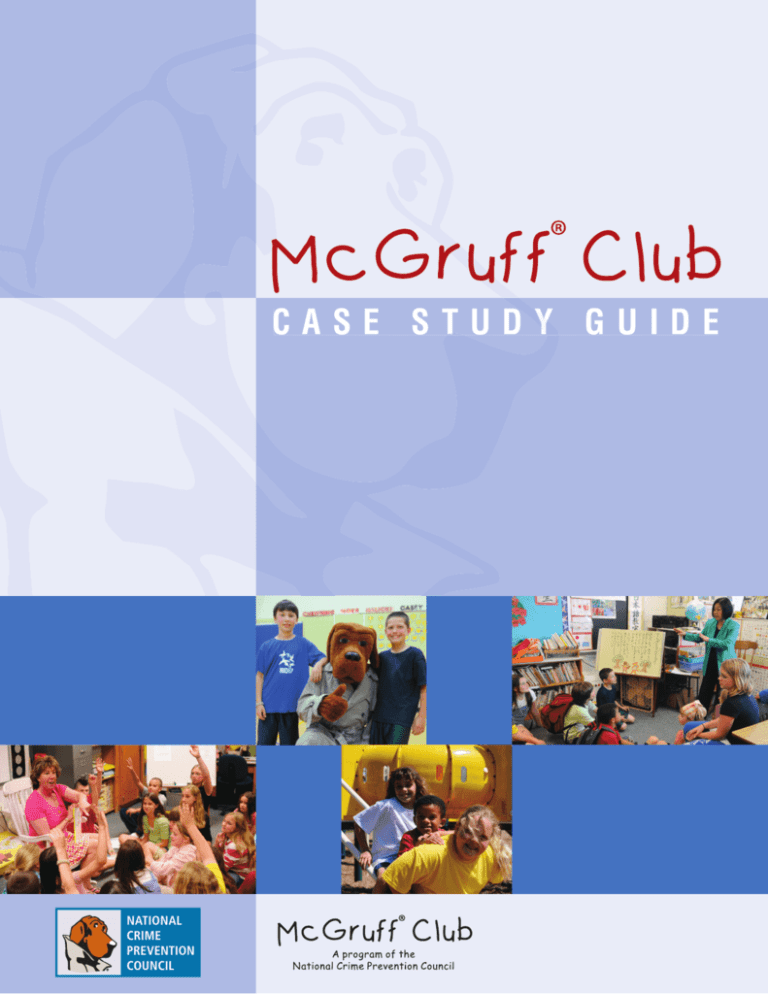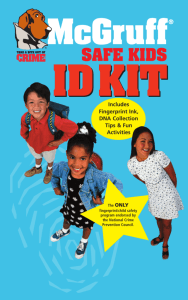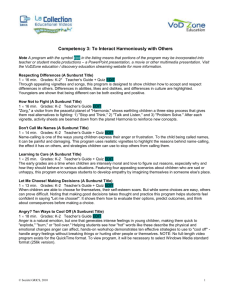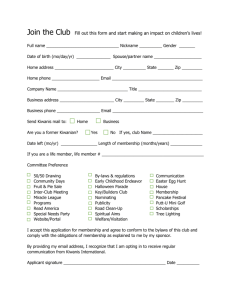
CASE STUDY GUIDE
NATIONAL
CRIME
PREVENTION
COUNCIL
NATIONAL
CRIME
PREVENTION
COUNCIL
The National Crime Prevention Council (NCPC) is a private, nonprofit tax-exempt [501(c)(3)] organization whose primary mission is to be the nation’s leader in helping people keep themselves, their
families, and their communities safe from crime. NCPC’s strategic plan for 2007 through 2011 is centered on four goals: protect children and youth; partner with government and law enforcement to
prevent crime; promote crime prevention and personal safety basics; and respond to emerging crime
trends. NCPC publishes books, kits of camera-ready program materials, posters, and informational
and policy reports on a variety of crime prevention and community-building subjects. NCPC offers
training, technical assistance, and a national focus for crime prevention: it acts as secretariat for the
Crime Prevention Coalition of America, more than 400 national, federal, state, and local organizations representing thousands of constituents who are committed to preventing crime. NCPC also
sponsors the National Crime Prevention Association, an individual membership association to promote resources and career development to crime prevention practitioners. It hosts two websites:
www.ncpc.org for adults and www.mcgruff.org for children. It operates demonstration programs in
schools, neighborhoods, and entire jurisdictions and takes a major leadership role in youth crime
prevention and youth service. NCPC manages the McGruff® “Take A Bite Out Of Crime®” public service advertising campaign. NCPC is funded through a variety of government agencies, corporate and
private foundations, and donations from private individuals.
This project was supported by Grant No. 2007-DD-BX-K144 awarded by the Bureau of Justice
Assistance. The Bureau of Justice Assistance is a component of the Office of Justice Programs,
which also includes the Bureau of Justice Statistics, the National Institute of Justice, the Office of
Juvenile Justice and Delinquency Prevention, the SMART Office, and the Office for Victims of
Crime. Points of view or opinions in this document are those of the author and do not represent
the official position or policies of the U. S. Department of Justice.
Copyright © 2009 National Crime Prevention Council
All rights reserved.
National Crime Prevention Council
2345 Crystal Drive, Suite 500
Arlington, VA22202
202-466-6272
www.ncpc.org
Welcome to
McGruff Club
or more than 25 years, McGruff the Crime Dog has been educating
Americans on preventing crime and staying safe. Now, McGruff Club will
teach and engage a new generation of children with trusted information from
the beloved icon. Children will learn what they can do to protect themselves
from crime and violence and help friends stay safe, and they will contribute to
the safety of their schools and neighborhoods by sharing that information
through service projects.
F
Children in McGruff Club will become aware of bullying, strangers, conflict
resolution, drugs, and other threats that they may face in their everyday lives. As
children learn how to respond to these issues, they will build skills to stay safe.
Children will also develop life skills including cooperation, empathy, responsible decision making, and respect for others, while building positive relationships with peers, school personnel, law enforcement officers, and other
members of the community. Community service projects will show children
that even though they are young, they can still play a part in making their
community safer.
This guide outlines the structure of the McGruff Club program and provides
examples of how elementary schools implemented the program. If you are
interested in learning more about McGruff Club, contact the National Crime
Prevention Council to speak with a member of the Children and Youth
Initiatives Team.
1
Understanding
McGruff Club
cGruff Club is a structured curriculum for children in grades 1–4. Each
grade features 16 scripted lessons that guide instructors through classroom
discussions and activities. The activities, incorporating proven teaching strategies
identified by the U. S. Department of Education, develop children’s critical
thinking and communication skills. The lessons for each grade build upon each
other, so children enhance their skills as they age through the program.
Knowledge is reinforced through service projects where children share what they
have learned with others and then reflect upon their learning and service
experiences.
M
Educators, counselors, youth center staff members, or law enforcement officers
can teach McGruff Club in just 30 minutes a week in school or as part of an
afterschool program or summer camp. The scripted, user-friendly lessons make
it easy for anyone to implement McGruff Club.
Program Goals
McGruff Club’s two goals are to
䡲 Increase children’s ability to ensure their personal safety
䡲 Foster the attitude in children that they have a responsibility to keep
their community safe
To accomplish these goals, the curriculum helps children
䡲 Recognize unsafe/dangerous behavior and situations (such as pressure to
try drugs or requests from strangers to share personal information)
䡲 Identify steps to take to manage unsafe/dangerous behaviors and situations (such as getting away from bullying and talking to trusted adults)
2
MCGRUFF® CLUB CASE STUDY GUIDE
䡲 Build skills so they can confidently keep themselves safe (such as communication and problem-solving skills)
䡲 Identify things they can do to keep the community safe (such as helping
friends in trouble and talking to others about safety)
䡲 Build skills so they can confidently take steps to keep their communities
safe (such as empathy, citizenship, and respect for others)
Program Structure
The McGruff Club program features 16 scripted lessons for each grade 1–4. The
lessons for each grade are divided into two units of eight lessons each. The lessons address a wide range of safety topics, from bullying and conflict resolution
to home and neighborhood safety.
The lessons in each grade build on previous lessons. For example, the concept of
bullying is introduced in first grade, with children learning to identify bullying
behaviors and to treat others with respect. Second grade students expand their
understanding of bullying, talking in more depth about the effects of bullying
on others and exploring various strategies for responding to bullying. Finally,
the concept is revisited in fourth grade, where students talk about the dangers of
cliques, rumors, and using technology to bully others (cyberbullying).
Unit Topics
Grade 1
Unit 1:Making Friends
Children learn how differences among individuals add value to the community. They identify bullying behaviors and learn how they can help a child
who is bullied by inviting that child to play or by telling an adult.
Unit 2:Staying Safe
Children discuss rules for staying safe at home when their parents are away
and identify people in their neighborhoods (such as law enforcement officers and teachers) who can help them stay safe.
Grade 2
Unit 1:Solving Problems
Children learn strategies for managing anger and problem-solving steps to
follow when they have a conflict with another child.
3
MCGRUFF® CLUB CASE STUDY GUIDE
Unit 2:Standing Up to Bullying
Children explore the effects of bullying and practice strategies for helping
other children who are picked on or teased.
Grade 3
Unit 1:Safe and Unsafe Communities
Children identify people and places in their neighborhood that make them
feel safe, and they discuss how to respond if they encounter weapons or
drugs in their community.
Unit 2:Communication
Children build skills in listening to and communicating with others so they
can better resolve conflicts, resist negative peer pressure, and help those who
are bullied.
Grade 4
Unit 1:Safety in Real and Online Communities
Children discuss how strategies to stay safe in real communities (such as not
sharing personal information with strangers and not bullying others) can
apply to their online activities.
Unit 2:Treating Others With Respect
Children explore stereotypes, discrimination, and prejudice and discuss how
to be more respectful of others in their daily lives.
An In-depth Look at the Lessons
Although each McGruff Club unit addresses a different safety topic, the units
follow a similar structure. The first lesson in each unit introduces the safety
topic and encourages children to share their thoughts and current understanding about the issues. Several lessons are dedicated to knowledge and skill-building, and use whole group and small group discussions, role plays, and other
activities to inform students about safety and give them opportunities to practice responding to situations. Each unit then features a service project where students share what they have learned with others. These projects are designed to
be completed during class time, and little additional planning is needed to successfully complete the projects. Finally, the children reflect upon the experience
of completing the service project and share their thoughts about the lessons.
Each lesson includes a letter from McGruff to students, handouts needed for the
activities, a supplemental worksheet that can be used if time allows, and an
4
MCGRUFF® CLUB CASE STUDY GUIDE
instructor journal page for teachers to note comments on the lesson. In addition,
each grade features a survey that can be used as a pre- and posttest tool. The 10question surveys are conducted during the first lesson of unit one for each grade
and give instructors an idea of what students already know about the issues that
will be addressed. The survey is conducted again during the last lesson of unit
two for each grade and indicates changes in student knowledge and attitudes as a
result of the lessons. Instructors may use these surveys to measure progress, or
they could be graded if instructors need to assess student performance.
The following unit outline provides an example of how lessons are structured.
Lessons
Grade 2, Unit 1:Solving Problems
Lesson 1:Introduction to Solving Problems
Children take a survey to indicate what they already know about problem
solving and then discuss as a class the problems they face in their everyday
lives.
Lesson 2:Violence in the Media
Children identify types of violence (yelling, hitting, etc.) that they see in television shows, movies, and computer games and share their personal views of
characters who engage in the fighting.
Lesson 3:The Effects of Fighting
Children learn that fighting in the media doesn’t show the full effects of violence, and they discuss the physical and emotional effects of fighting.
Lesson 4:Starting To Solve Problems
Children are introduced to a process for solving problems and discuss the
first two steps: managing their anger when they have a problem and stating
what the problem is and how they feel about the situation.
Lesson 5:Brainstorming Solutions
Children practice the remaining three steps of the problem-solving process:
brainstorming solutions to the problem, choosing a solution, and acting on
that choice.
Lesson 6:Poster Project, Part One
Students begin working on posters that communicate the five steps of the
problem-solving process. By displaying the posters in the school or a local
5
MCGRUFF® CLUB CASE STUDY GUIDE
youth center, students are serving the community by raising awareness of
conflict resolution.
Lesson 7:Poster Project, Part Two
Students complete work on their posters.
Lesson 8:Reflection
Students discuss how it felt to create the posters and have them displayed for
others to see.
McGruff Club Enhancements
Various resources can enhance your McGruff Club program. These resources are
optional, but they expand children’s understanding of the safety messages presented in the curriculum. Many of these resources can be taken home and
shared with parents, serving as reminders of McGruff’s safety tips.
McGruff Readers
McGruff Readers are storybooks that show children the words to say and the
actions to take when they encounter bullying and other dangerous situations in
their neighborhoods. McGruff, his nephew Scruff, and
other characters experience problems that face children
today. The characters model responsible decision making
and problem-solving skills, demonstrating safe strategies
for managing dangers. NCPC has developed two stories for
each grade, corresponding to the messages in the two
McGruff Club units for each grade.
The McGruff Readers can be used in class to supplement
the McGruff Club lessons. The lessons offer suggestions on
how instructors can use the McGruff Reader stories to reinforce the lessons’ messages. The McGruff Readers can also
be sent home with students to share with their families.
Parents can read these books with their children over and
over again, reinforcing the safety messages and developing
children’s literacy. The books will prompt discussions
among parents and children, giving parents insight into
6
MCGRUFF® CLUB CASE STUDY GUIDE
their children’s experiences, what they are learning through McGruff Club, and
how they can guide children to make smart and safe choices.
McGruff Activity Books
The McGruff Activity Books offer math-based activities, games, and craft projects that reinforce each
grade’s safety messages. The books can be used during class or sent home with children to share with
their families. While all of the books incorporate
math-based activities, the activity books for grades 3
and 4, in particular, reinforce age-appropriate math
skills as identified by the National Council of
Teachers of Mathematics, including arithmetic, fractions, geometry, and weights and measures.
7
McGruff Club
in Action
lementary schools and Boys & Girls Clubs from across the country have used
McGruff Club to teach children. The following examples highlight how
schools have implemented the program.
E
Las Cruces Public Schools,
Las Cruces, New Mexico
Las Cruces Public School District is the second largest school district in New
Mexico. Located 45 miles north of the Mexican border, it encompasses the City
of Las Cruces, the villages of La Mesilla and Doña Ana, and covers the middle
third of Doña Ana County. Many of the district’s 24,000 students are from
Spanish-speaking families living in low socio-economic communities. McGruff
Club has served as a powerful tool to educate and teach the importance of safety and crime prevention to children and their families.
While all 24 elementary schools in the district use McGruff resources to teach
children, four have been particularly successful at implementing McGruff Club.
At Central Elementary School, guidance counselor Maria Escobedo-Vicario used
McGruff Club as part of an afterschool program. She worked with AmeriCorps
members to teach children the weekly lessons. Ms. Escobedo-Vicario found that
the students enjoyed the service project lessons, which provided the students
with time to interact with one another and discuss how they could help their
neighborhoods and small communities.
Rebekah Martinez, the guidance counselor at Doña Ana Elementary, visits each
classroom at the school over the course of the week. This enabled her to teach
McGruff Club lessons with each grade and present students with a unified
8
MCGRUFF® CLUB CASE STUDY GUIDE
vision of safety at school and in the neighborhood. Her observations of student
behavior and conversations have led her to believe that the students are incorporating McGruff’s safety messages and tips into their daily lives. Ms. Martinez
augmented her McGruff Club lessons with visits from McGruff. (The county
sheriff’s department owns a McGruff costume that is used for community
appearances.) She shared that the children’s faces light up each time McGruff
walks into the room.
Mesilla Elementary’s guidance counselor,
Ollie Ziehl, also teaches McGruff Club during the weekly guidance classes she provides to each classroom. The students particularly enjoyed the lessons involving role
plays and the friendship quilt service project (grade 1, unit 1). When children
designed posters as part of the lesson, Ms.
Zeihl displayed the posters in the classrooms. The children appreciated seeing
their work displayed, and the posters
served as daily reminders of McGruff’s safety messages.
Many law enforcement agencies across
the country possess McGruff costumes
and can provide McGruff appearances
to schools. To arrange an appearance,
contact your local law enforcement
agency. A crime prevention officer or
community policing officer could provide you with assistance. If your local
agency does not have a costume, you
can contact the National Crime
Prevention Council to see if other agencies in your area do have one.
In addition to teaching the lessons to children, Ms. Ziehl worked to engage parents
as well. She organized a parent-teacher
night where McGruff and Scruff were surprise visitors. The parents and their
children were enthusiastic, and everyone lined up to get their pictures taken
with them. Ms. Ziehl also worked to engage parents by encouraging their participation in the McGruff House program. McGruff House gives parents and neighbors an opportunity to protect children in the neighborhood by volunteering to
call for help if a child asks for assistance. By disseminating information about
this program to parents and neighbors at shopping malls and community
events, Ms. Ziehl was instrumental in
bringing the McGruff House program to
To learn more about the McGruff House
Mesilla.
Las Cruces’ fourth McGruff Club site is
Sonoma Elementary. Mr. Martinez, who
facilitates McGruff Club, has been with the
9
program and how McGruff House
volunteers assist children in need, visit
NCPC’s website: www.ncpc.org.
MCGRUFF® CLUB CASE STUDY GUIDE
school for the past four years. His favorite memory with McGruff Club was when
both McGruff and Scruff attended their annual Fall Festival. He said the students
had an opportunity to interact with both characters and it was a huge hit.
For future activities, he plans to focus
more on how the core curriculum was
McGruff.org (www.mcgruff.org) features
implemented and students’ reactions to
a variety of games, comic stories, and
the lessons. McGruff appearances and
mcgruff.org will supplement the lessons.
tips for children on issues ranging from
alcohol and drug prevention to bullying
Leandro Martinez at Sonoma Elementary
and Internet safety. In addition to using
enhanced the McGruff Club curriculum lesthe educational games during class to
sons with games and activities from
NCPC’s children’s website, mcgruff.org.
reinforce safety messages, you can
The elementary school as a whole is techencourage children to visit the site with
nology-oriented, and NCPC’s online games
their parents and siblings at home.
provided an opportunity to not only reinforce safety messages from the curriculum
but also to enhance children’s skills and comfort in using technology. Many students at the school don’t have computers at home, so they found the games on
mcgruff.org exciting and novel. Mr. Martinez would often use the Internet during the reflection lessons at the end of each unit. He would identify games and
stories from the website that related to the unit’s topic and guide students to
those activities.
South Boston Elementary School,
South Boston, Virginia
South Boston Elementary School partnered with the South Boston Police
Department and the school’s parent-teacher organization to implement McGruff
Club as part of their afterschool programming. Officer Julianna Berry taught
the McGruff Club lessons once a week. Even though Officer Berry was not a professional educator, she found the structured curriculum easy to use, and the
scripted lessons provided guidance on what information to communicate to
children and how to facilitate various learning activities. The school’s two guidance counselors and members of the PTO also supported the program. The children participating in the program benefited from interacting with these caring
adults and learning more about the role of law enforcement in keeping the
community safe. The students particularly enjoyed learning about community
10
MCGRUFF® CLUB CASE STUDY GUIDE
safety professionals (such as law enforcement officers and fire fighters) and the
service project where they wrote letters to these professionals thanking them for
their work in the community.
Officer Berry enhanced the McGruff Club
lessons by playing McGruff songs for the
children. The first and second grade students she worked with learned the lyrics
and performed the songs for their parents
and other students at a school assembly.
McGruff songs are available for download through the i-Tunes library and at
www.musicasmessage.com. The songs
address issues including bullying, fighting, and neighborhood safety.
Patuxent Elementary School,
Upper Marlboro, MD
This elementary school just outside of Washington, DC, serves more than 500
students. The school’s guidance counselor, Diane Privette, taught McGruff Club
during her weekly visits to classrooms. Her students enjoyed the McGruff Club
lessons, and Ms. Privette felt that the lesson where children identified safe places
in their neighborhoods was especially valuable. The third-grade students, who
learned about the dangers of drugs and alcohol, participated in a larger service
project around the issue of drinking and driving. Students and staff conducted a
march in the neighborhood to remind community members of the dangers of
drunk driving.
Ms. Privette supplemented the McGruff
Club curriculum with various resources
to remind students throughout the
school of McGruff’s safety messages. One
resource, Get the Message, included short
messages from McGruff for each day of the
week. Students read these messages about
bullying, home safety, and other issues
during morning announcements. She also
displayed a poster of McGruff in the main
lobby of the school, and she brought a
plush McGruff doll when she visited the
classrooms. The students enjoyed holding
and interacting with the doll.
11
Get the Message! and other publications,
posters, videos, and other educational
resources featuring McGruff can supplement your McGruff Club program. Giveaway items, including McGruff dolls, pencils, and key chains, that feature safety
messages can be purchased in bulk quantities and given to students in recognition
of their participation in McGruff Club. To
learn more about these resources, visit
NCPC’s website: www.ncpc.org.
Conclusion
hildren face myriad threats to their safety, and McGruff Club addresses
these many threats in a comprehensive, easy-to-use resource. The age-appropriate safety information is based on research for keeping children safe and is
presented through learning activities designed to build children’s problem-solving and communication skills, and increase their sense of empathy, respect, and
citizenship. The curriculum, with its structured, scripted lessons and handouts,
includes everything needed to successfully implement the program in just 30
minutes a week for 16 weeks. But McGruff Club instructors also have a wealth
of additional resources they can use to enhance the program. From reading
activity books that incorporate literacy and numeracy, to Internet activities that
bring technology into the classroom, to give-away items that acknowledge children’s accomplishments, instructors can build on the curriculum’s solid foundation and customize the program for their location. If you are interested in learning more about McGruff Club and how you can bring the program to your
school or youth center, contact the National Crime Prevention Council and
speak to a member of the Children and Youth Initiatives Team.
C
12
2345 Crystal Drive
Suite 500
Arlington, VA 22202
202-466-6272
Fax 202-296-1356
www.ncpc.org







